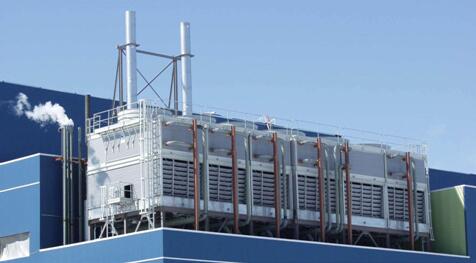Another method of Cooling Tower Water Treatment: ozone

The use of ozone in cooling tower treatment has received a great deal of attention in recent years. In the prevention and control of legionnaires disease (legionella) causing microbes, ozone has taken an eminent roll. The specific characteristics of the disinfectant make sure ozone gets the job done where others fail.
There are additional specific characteristics that give ozone a great deal of appeal to cooling tower users. They include:
Minimal on-site chemical inventory
With the advent of SARA Title III and other legislation, the storage and handling of chemicals in general, and biocidal agents in particular, is more regulated and difficult. Since ozone is generated as it is used, these concerns are minimized.
Little or no toxicant discharge
The Clean Water Act and state and local regulation are placing increased pressure on cooling tower discharge into receiving streams. The high toxicity of ozone in water solution makes it an effective biocide. However, its rapid decomposition minimizes any downstream toxicity concerns. The by-products of ozonation of cooling tower water have not yet been subjected to the same scrutiny as have the by-products of halogen application, and are consequently not as stringently regulated.
The potential of water conservation
Numerous case histories of the use of ozone in “zero discharge” cooling tower applications have been published. In water-short parts of the world, this carries an obvious appeal.
Advantages of Ozone Application in Cooling Tower Water
· Safe and easy in use
· Low maintenance costs
· Ozone is produced on-site and requires no storage of dangerous chemicals
· Ozone requires no additional disinfectants
· No cocktail of disinfectants necessary. Micro-organism can not get resistant to ozone after prolonged use of ozone.
· High efficiency as disinfectant. A residual ozone concentration of 0.1 to 0.2t ppm is in most cases very effective in keeping the cooling tower and the cooling circuit clean.
· Very effective in removing biofilms
· Higher efficiency of heat exchangers due to reduced biofilm formation.
· Due to good biofilm removal capacities very effective against Legionella.
· No chlorinated compounds. Very low corrosion rates in the system.
· No persistent chemicals or disinfectants in bleed. Ozone breaks down to oxygen.
· In some cases ozone can replace disinfectants and also dispergents and inhibitors.
· In many cases a higher concentration factor is possible.
· Lower operational costs and in many cases a lower overall costs.
· Ozone is effective in a wide pH range.
· Also effective for mussel growth.
System Design
In the design of a proper ozone disinfected cooling tower, one needs to take care of the following points:
Suppletion water with high hardness and / or high COD levels is less suitable for ozone based cooling towers
Retention time in the system - the half time of ozone is normally less than 10 minutes in cooling systems. To assure an adequate residual ozone concentration it is necessary to start with an adequate begin concentration.
Dead spots - due to the fact that ozone depletes to oxygen, spots with little circulation have to be prevented.
Temperature - the solubility of ozone and the half life time of ozone decreases at higher temperatures. Water temperatures that exceed 110 degrees F, as high temperatures decrease ozone half-life substantially and reduce overall effectiveness of the ozone treatment.
Also, the ozone generator should be located in an air conditioned area for best ozone generation efficiency (gm / kW input). Excessive ambient temperatures (greater than 40C) could damage the generation system or controls, and will reduce generation capacity.
Material- Material of construction in the ozone treated system should be compatible with ozone, including water pump parts and flange gaskets. The ozone distribution line from the generator to the gas / water contactor carries the highest concentration; therefore, the line material must be stainless steel or PVC.
Additional Benefits of Ozone Application in Cooling Tower Water
Scale and biological deposits reduce the ability of refrigerant condensers and industrial process heat exchangers to transfer heat. By inhibiting or removing biological deposits (with an associated displacement of scale) more effectively than chemical treatment, ozone cooling tower water treatment will improve the performance of the cooling system. Case studies have shown ranges from no improvement in efficiency to a 20% improvement in performance of chilled water systems. Energy savings should be estimated for each individual application, based on the actual operating condition of the condenser or heat exchanger and the type of fouling present.
Field tests have demonstrated that the use of ozone in place of chemicals for water treatment will reduce the blow down rate. As a result, cost savings accrue from decreased chemical use and make up water requirements, from a reduction of waste water volume, and from avoidance of waste water disposal surcharges due to residual chemicals in the blow down. There are also environmental benefits, as fewer chlorine or chlorinated compounds and other chemicals are discharged. When ozone oxidizes the biofilm that serves as a binding agent adhering scale to heat exchange surfaces, scale buildup on heat exchange surfaces is reduced, and higher heat transfer rates are achieved. Increasing a condenser heat transfer rate will reduce the chiller head pressure, which then allows the chiller to operate more efficiently and consume less energy.
BIOFILM
A biofilm is a layer of microorganisms contained in a matrix (slime layer), which forms on surfaces in contact with water. Incorporation of pathogens in biofilms can protect the pathogens from concentrations of biocides that would otherwise kill or inhibit those organisms freely suspended in water.
Biofilms provide a safe haven for organisms like listeria, E. coli and legionella where they can reproduce to levels where contamination of products passing through that water becomes inevitable.
Previous: Winery application
Next: Swimming pool
Becodrive Company Limited
Tel:+8613560466027
E-mail:ozone.qaos@hotmail.com
Web:www.becodrive.com
Add:1th Liulian Road, Jianggao, Baiyun, Guangzhou